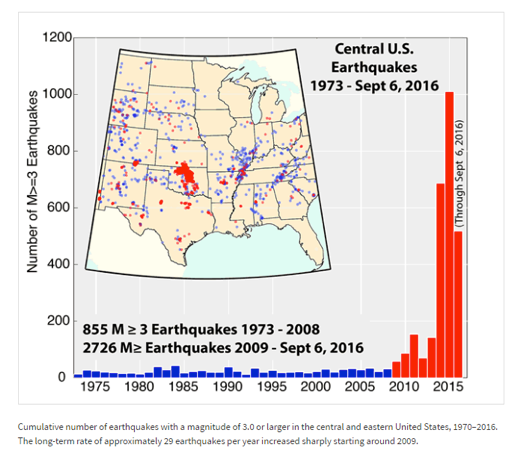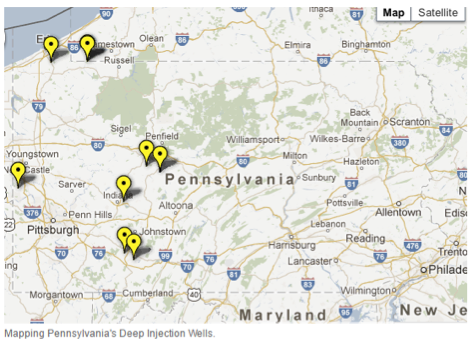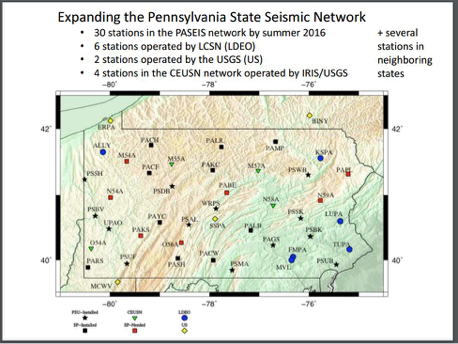Managing Induced Seismicity from Wastewater Injection Wells in Pennsylvania

Oklahoma has surpassed California as the most earthquake-prone state in the nation due human activity: the disposal of wastewater from oil and gas drilling in injection wells.
Oklahoma has surpassed California as the most earthquake-prone state in the nation. The Sooner State experienced more than 900 earthquakes in 2015 and has experienced hundreds more in 2016, including a 5.8-magnitude earthquake in early September that tied a record as the strongest in state history.
The culprit? Not natural tectonics, but human activity. Seismologists call it induced seismicity—specifically, from the disposal of wastewater from oil and gas drilling in injection wells.
As discussed below, the expansion of hydraulic fracturing has generated huge increases in the volume of oil and gas wastewater being disposed of in injection wells. With that has come a sharp spike in man-made earthquakes. And, because wastewater injection is still the cheapest method of disposal compared to emerging wastewater management technologies, the situation is not likely to change soon.
Here in Pennsylvania, demand for disposal wells is likely to increase. The Commonwealth must put in place appropriate permit conditions to safeguard against induced seismic events, and has the opportunity to do so.
Induced Seismicity in Oklahoma
For generations, industrial waste fluids of all types, including oil and gas wastewater, have been injected underground for disposal in the U.S., and scientists have known for decades that the practice can lead to earthquakes. Injection wells can be poorly sited—located too close to a known geologic fault, or too close to a fault that was not identified in the siting process. More often, the problem is operational. Too-high volumes, injected under too-high pressure and/or at too-fast rates, push into geologic faults and lubricate them. Under these conditions, the faults can move suddenly, causing earthquakes.
In Oklahoma, the majority of the earthquakes that have occurred over the past few years have been below 2.0 in magnitude, which can be imperceptible to humans. But according to the U.S. Geological Survey, Oklahoma has gone from an historic average of 1.5 earthquakes per year in the state to 2.5 per day. Geologists have determined that the current seismicity rate is now about 600 times greater than the background seismicity rate. An increase of that magnitude is very unlikely to be the result of any natural process.
Since mid-2015, Oklahoma has ordered operators of some injection wells in seismically active regions of the state to reduce the volume of wastewater injected, in an attempt to reduce the occurrence of earthquakes in those regions. There have been more than 500 earthquakes in 2016 of magnitude 3 or greater, and in response to the 5.8-magnitude September quake, Oklahoma officials ordered oil and gas operators to shut down three dozen wastewater disposal wells in the vicinity. Still, the earthquakes have continued. In September 2016, EPA recommended that Oklahoma oil and gas officials consider a moratorium on wastewater injection in the seismically active parts of the state, because regulatory efforts to date have been ineffective.
Induced Seismicity in Other Oil & Gas States
Tens of thousands of oil and gas wastewater injection wells (including those in Oklahoma) are permitted across the United States, and induced seismic events have until recent years been rare occurrences. Propelled by the growth of hydraulic fracturing and horizontal drilling technologies, domestic oil production has increased 70%, and natural gas production has risen by 37% over the last ten years. Each hydraulically fractured well can produce millions of gallons of wastewater.
While there are other waste management technologies that are available to dispose of the wastewater besides deep well injection—such as recycling or evaporation—these technologies are significantly more expensive than injection well disposal. With the rise of hydraulic fracturing, the problem of disposing of wastewater from the process has grown apace. And, starting around 2009, so have the number of induced earthquakes.

Source: http://earthquake.usgs.gov/research/induced/overview.php
And not just in Oklahoma.
Texas, Ohio, and Colorado have also seen significant increases in the number and severity of man-made earthquakes stemming from deep well injection of drilling waste.1 In 2014, Ohio enacted emergency rules in response to induced earthquakes that occurred in 2012. Those rules included new permit conditions requiring all new drilling sites2 within three miles of a known fault or seismic activity with a magnitude of 2.0 or higher to install seismic monitoring equipment, in order to make data directly available to regulators. The permit conditions further require that if seismic activity of 1.0 magnitude or greater is felt, drilling will be paused for evaluation; and if a link is found, the operation will be halted.
The Texas Railroad Commission, meanwhile, has rejected 11 wastewater injection well applications since 2014, and placed special conditions on many others due to seismic issues. After a 2015 earthquake that was linked to wastewater injection, the Colorado Oil and Gas Conservation Commission began requiring seismic monitoring at disposal wells that inject more than 10,000 barrels per day.
Is Pennsylvania the Next State to Quake?
Pennsylvania has become the nation’s second largest producer of natural gas, thanks to the immense productivity of the Marcellus Shale formation and early production from Utica and other shales within the state. Until now, most wastewater destined for deep well injection has been shipped to Ohio for disposal; however, the costs of transportation and disposal are prompting new interest in wastewater injection in Pennsylvania. There are less than ten injection wells currently operating in Pennsylvania, but more are likely to be developed.3

Source: https://stateimpact.npr.org/pennsylvania/2011/09/22/burning-question-where-are-pas-deep-injection-wells/
Will Pennsylvania join the list of states that are increasingly plagued by induced seismicity from oil and gas wastewater injection? It depends on how—or whether—state government responds to the data and experience of other states and adopts proactive policies. To protect public safety and public and private property, the risks associated with oil and gas wastewater injection can—and must—be managed by the Commonwealth with strict monitoring and appropriate permit conditions, over and above federal requirements.
Current Regulation for Injection Wells in Pennsylvania
Federal Primacy
Oil and gas wastewater injections wells are defined as Class II wells by EPA and are subject to the requirements of EPA’s Underground Injection Control (UIC) program.4 These requirements are designed to be adopted by states, territories, and Native American tribes. Primary enforcement authority, often referred to as primacy, over injection wells either rests with EPA or with states, territories, or tribes that obtain UIC primacy from EPA.
Primacy programs are authorized under two sections of the federal Safe Drinking Water Act (SDWA). Section 1422 requires that primacy applicants meet EPA’s minimum requirements for UIC programs. Section 1425 of SDWA, which applies only to Class II wells, requires primacy applicants to demonstrate that their standards, which need not be the same as EPA’s minimum standards, are effective in preventing endangerment of underground sources of drinking water (USDW).
If a state, territory, or tribe does not obtain primacy for all or some well classes, EPA implements the UIC program directly through one of its regional offices. Currently, EPA implements the UIC program for all well classes in nine states—including Pennsylvania—two territories, and for all U.S. Native American tribes except the Navajo Nation and Fort Peck (the Montana homeland of the Assiniboine and Sioux tribes).
To address induced seismicity concerns associated with disposal injection wells, EPA requires that the applicant for an injection well permit provide information about any geologic faults in the area of injection and an evaluation of whether they pose a seismic risk. EPA also limits injection pressures of permitted wells to reduce the chance of induced seismicity. But as experience in Oklahoma, Ohio, Texas, and Colorado show, induced seismicity is still occurring with alarming—and increasing—frequency. Indeed, EPA has been criticized for its management of the UIC program by the Government Accountability Office (GAO).5 Among GAO’s findings was that EPA-approved safeguards to protect against contamination of underground sources of drinking water do not address emerging underground injection risks, including induced seismic activity.
It is clear that further regulatory action is warranted at both state and federal levels.
Injection Well Permitting in Pennsylvania
Pennsylvania does not have primacy to directly permit underground injection wells; however, two permits are needed for an injection well located within the state:
- An Underground Injection Control permit from EPA; and, once that has been awarded,
- A well permit from the Pennsylvania Department of Environmental Protection (DEP) under Chapter 78 of the Pennsylvania Code.6
- It is important to note here that DEP may place special conditions on its permit under authority granted to it by Pennsylvania’s Solid Waste Management Act7 and Clean Streams Law8
Pennsylvania’s Statewide Monitoring Network
Pennsylvania is uniquely positioned to use its permitting authority to enhance its ability to manage the potential for seismic activity from wastewater injection, thanks to a partnership between the Department of Environmental Protection (DEP) and the Department of Conservation and Natural Resources (DCNR). In 2015, these departments jointly created a statewide seismic monitoring network (PASEIS), which includes a network of 30 real-time seismic monitoring stations (seismometers), deployed fairly uniformly across the Commonwealth. Most of these stations are located on state park lands. In addition to the 30 fixed stations, five additional seismometers will be available for rapid deployment to investigate seismic events in detail by gathering data on aftershocks. Such data could be valuable in identifying the cause of a particular event.

Source: http://extension.psu.edu/natural-resources/natural-gas/webinars/seismicity-in-pennsylvania-and-the-pennsylvania-state-seismic-network/seismicity-in-pennsylvania-and-the-pennsylvania-state-seismic-network-powerpoint; locations may change as the network evolves.
Leveraging PA’s Seismic Network
When considering new oil and gas wastewater injection well permits, Pennsylvania should leverage the capabilities of its new seismic monitoring network in order to avoid and minimize the risk of seismic activity from the operation of oil and gas wastewater wells and to protect public health, safety, and property. This can be done by borrowing and improving on the seismic monitoring requirements of states like Ohio and Colorado. When it comes to effectively managing the risk of induced seismicity, an effective Pennsylvania permitting regime ought to be based on well-understood science and operational practices. Overlaid on top of existing EPA UIC requirements and leveraging PASEIS, Pennsylvania’s permitting requirements should contain the following essential elements:
- A requirement for all injection well operators to install a seismometer on-site— which becomes part of state seismic network—with installation and maintenance paid for by the well operator. The costs of monitoring a potentially hazardous activity and the costs of performing the regulatory activity associated with it should be borne by the applicant proposing to conduct such activity, as is the case with many other DEP fees.
- Specification of maximum allowable injection rates, pressures, and volumes
- Automatic shut-down provisions in the event of the detection of seismic activity
- Data transparency, with data available to DEP, the operator, and the public
The data that would be generated from PASEIS, and from on-site seismic monitoring of each injection operation, coupled with strict injection well operating parameters that are written into each permit, would provide the Commonwealth with the ability to detect, minimize, and perhaps prevent, seismic activity resulting from oil and gas wastewater injection.
Requiring developers to install state-owned-and-operated seismometers at new injection wells is reasonable. The investments to meet the permitting requirements proposed here are minimal and can provide operators with liability protection. While the Commonwealth experiences a relatively low level of earthquake activity compared to naturally active states such as Alaska and California, earthquakes do naturally occur in Pennsylvania, and parts of Pennsylvania have been impacted by earthquakes located outside the state’s borders. Induced seismic events have also been caused in Pennsylvania by blasting activity in quarries, coal mines, and other mines.9 The existence of on-site and network seismic data that is gathered independently by the Commonwealth or its assigns could assist injection well operators in ruling out their operations as the cause of a particular seismic event and thereby avoid damage claims resulting from their operations.
A state requirement of an on-site seismic monitor for oil and gas wastewater injection wells simply makes sense for the industry and the public.
Recommended Permit Conditions for PA’s Injection Wells
Pennsylvania is obliged to protect public health and safety and the environment in permitting any new disposal wells for oil and gas wastewater. The national experience of seismic events caused by injection of oil and gas wastewater demands prudence by Pennsylvania in considering new injection well applications, or applications to convert existing production wells to injection wells. Further, as discussed above, prudent, scientific data-based requirements can simultaneously protect the public and natural resources and protect injection well operators from liability. Pennsylvania can establish the needed permitting regime under its existing legal authority.
To further the elements described above, Pennsylvania’s permit conditions for oil and gas wastewater injection wells should include, at minimum, the following 13 provisions:
Required Network Seismometer
- Require the installation of a Commonwealth seismic network-compatible seismometer10 at each injection well, tied into and becoming part of Pennsylvania’s SEIS upon installation. The applicant should pay all installation costs for the seismic equipment.
- The injection well permittee must allow access to the seismometer by state network operators as necessary for inspection during the operational life of the injection well.
- Data from the seismometer will be shared by the injection well operator, DEP, and the state network in real time.
- The injection well permittee must post a bond or establish a trust fund for the maintenance and operation of the seismometer for the lifetime of injection operations.
- The injection well operator must perform all maintenance of the seismometer and submit records of same to DEP on a quarterly basis for the life of injection well operation.
Maximum Injection Rates and Pressures - Require submission of all geologic/geophysical data and analysis of the proposed well location undertaken by permit applicant, including 6-12 months of pre-application seismic monitoring to establish site background levels of seismicity.
- The DEP permit should specify maximum wastewater injection volumes, pressures, and rates of injection for each injection well permit.
Automatic Shut-Down Provisions11 - Any single seismic event of magnitude 2.0 or greater that is detected within a six-mile radius of the injection well will trigger immediate shutdown of injection operations. Resumption of injection may only take place upon DEP approval.
- Any cumulative series of five or more seismic events equal to or greater than magnitude 1.0 within a six-mile radius of the injection well will trigger immediate shutdown of injection operations. Resumption of injection operations may only take place upon DEP approval.
Data Management - The permittee will continuously monitor injection volumes, rates, and pressures, and report such data either continuously or monthly to DEP.
- All operational monitoring data for the entire operating life of the injection well will be provided to DEP upon cessation of injection operations and decommissioning of the well.
- The operator will submit all well integrity monitoring data to DEP on a quarterly basis.
Data Transparency - All data either transmitted or submitted to DEP will become part of the state’s Exploration and Development Well Information Network (EDWIN).12
Conclusion
With the likelihood of demand for additional oil and gas wastewater disposal wells in Pennsylvania, and absent policies and requirements that mandate the use of alternative treatment technologies that would avoid the need for injection disposal, the Commonwealth must have strong permit requirements for injection wells that protect public safety, protect public and private property, and natural resources, and that assist in protecting well operators from liability where their operations are not at fault for seismic events. The permit conditions described in this brief, at a minimum, should be adopted by the Commonwealth.
John Quigley
Senior Fellow, Kleinman CenterJohn Quigley is a senior fellow at the Kleinman Center and previously served on the Center’s Advisory Board. He served as Secretary of the PA Department of Environmental Protection and of the PA Department of Conservation and Natural Resources.
Barry, Erin, Oil, gas drilling has Oklahoma all shook up. Can anything be done about it?, CNBC, Sept. 25, 2016, accessed Sept. 28, 2016, http://www.cnbc.com/2016/09/25/oil-gas-drilling-has-oklahoma-all-shook-up-can-anything-be-done-about-it.html
Chokshi, Niraj and Fountain, Henry, Oklahoma Orders Shutdown of Wells After Record-Tying Earthquake, The New York Times, Sept. 3, 2016, accessed Sept. 28, 2016, http://www.nytimes.com/2016/09/04/us/earthquake-ties-record-for-strongest-in-oklahoma-history.html
Hanson, L., Habicht, S., and Faeth, P., Potential Environmental Impacts of Full-development of the Marcellus Shale in Pennsylvania, CNA, Sept. 2016, accessed Sept. 29, 2016, https://www.cna.org/cna_files/pdf/MarcellusPA_FullReport.pdf
Legere, Laura, Marcellus operators looking for space underground, Pittsburgh Post-Gazette, April 7, 2014, accessed Sept. 29, 2016, http://powersource.post-gazette.com/powersource/features-powersource/2014/04/08/Injection-well-fracking-wastewater-disposal/stories/201404080030
Nyblade, Andy, Seismicity in Pennsylvania and the Pennsylvania State Seismic Network (PASEIS), May 19, 2016, http://extension.psu.edu/natural-resources/natural-gas/webinars/seismicity-in-pennsylvania-and-the-pennsylvania-state-seismic-network/seismicity-in-pennsylvania-and-the-pennsylvania-state-seismic-network-powerpoint
Ohio Department of Natural Resources, Underground Injection Control (UIC), http://oilandgas.ohiodnr.gov/industry/underground-injection-control#news
Pennsylvania Code, Chapter 78. Oil and Gas Wells, http://www.pacode.com/secure/data/025/chapter78/chap78toc.html#78.18
Pennsylvania Department of Conservation and Natural Resources, DCNR, DEP Increasing Efforts to Monitor Seismic Activity in Pennsylvania, Sept. 29, 2015, http://www.dcnr.state.pa.us/cs/groups/public/documents/news/DCNR_20031306.pdf
Pennsylvania Department of Conservation and Natural Resources, Earthquakes in Pennsylvania, http://www.dcnr.state.pa.us/topogeo/hazards/earthquakes/index.htm
Pennsylvania Department of Conservation and Natural Resources, PA*IRIS/WIS Modernization Project, http://www.dcnr.state.pa.us/topogeo/econresource/oilandgas/EDWIN_home/
Pennsylvania Department of Environmental Protection, Injection Wells for Enhanced Recovery and Disposal, http://www.elibrary.dep.state.pa.us/dsweb/Get/Document-103465/8000-FS-DEP2250.pdf
Pennsylvania Department of Environmental Protection, Waste Requirements and Information for the Oil and Gas Industry, http://www.dep.pa.gov/Business/Energy/OilandGasPrograms/OilandGasMgmt/Oil-and-Gas-Related-Topics/Pages/Waste.aspx
Phillips, Susan, Burning Question: Where Are Pa.’s Deep Injection Wells?, StateImpactPennsylvania,Sept. 22, 2011, accessed Oct. 6, 2016, https://stateimpact.npr.org/pennsylvania/2011/09/22/burning-question-where-are-pas-deep-injection-wells/
Quigley, John, Study: Marcellus drilling could choke on its own waste, John Quigley’s A Green Thing Blog, Jan. 24, 2013, accessed Sept. 30, 2016, http://johnhquigley.blogspot.com/2013/01/study-marcellus-drilling-could-choke-on.html
Quigley, John, Ohio faults fracking for quakes, John Quigley’s A Green Thing Blog, April 4, 2014, accessed Sept. 30, 2016, http://johnhquigley.blogspot.com/2014/04/ohio-faults-fracking-for-quakes.html
Revkin, Andrew, Oklahoma’s Options Now That State and Federal Scientists Confirm Big Earthquake Impact from Water Disposal, The New York Times, April 24, 2015, accessed Sept. 26, 2016, http://dotearth.blogs.nytimes.com/2015/04/24/oklahomas-options-now-that-state-and-federal-scientists-confirm-big-earthquake-impact-from-water-disposal/?_r=0
Soraghan, Mike, EPA suggests partial disposal moratorium in Okla, Energywire, Oct. 7, 2016, accessed Oct. 7, 2016, http://www.eenews.net/energywire/2016/10/07/stories/1060043991
Soraghan, Mike, Texas acknowledges ‘potential’ link between drilling operations, quakes, Energywire, August 25, 2016, accessed Oct. 7, 2016, http://www.eenews.net/energywire/2016/08/25/stories/1060042020
Talley, Tim, Oklahoma Geologists Also See Earthquake-Injection Well Link, Insurance Journal, April 23, 2015, accessed Oct. 7, 2016, http://www.insurancejournal.com/news/southcentral/2015/04/23/365481.htm
U.S. Energy Information Administration, Monthly Crude Oil and Natural Gas Production, Sept. 30, 2016, http://www.eia.gov/petroleum/production/
U.S. Energy Information Administration, Natural Gas Gross Withdrawals and Production, http://www.eia.gov/dnav/ng/ng_prod_sum_a_epg0_vgm_mmcf_a.htm
U.S. Environmental Protection Agency, Class II Oil and Gas Related Injection Wells, https://www.epa.gov/uic/class-ii-oil-and-gas-related-injection-wells#well_types
U.S. Environmental Protection Agency, Protecting Underground Sources of Drinking Water from Underground Injection (UIC), https://www.epa.gov/uic
U.S. Environmental Protection Agency, End-Of-Year (EOY) Review Oklahoma Corporation Commission (OCC) Underground Injection Control (UIC) Program, Sept. 22, 2016, http://www.eenews.net/assets/2016/10/07/document_ew_01.pdf
U.S. Environmental Protection Agency, Region III, Statement Of Basis For U. S. EPA’s Underground Injection Control (UIC) Program Draft Class IID Permit Number PAS2D219BWAR For Bear Lake Properties, LLC 3000 Village Run Road, Unit 103, #223 Wexford, Pennsylvania 15090, https://www.epa.gov/sites/production/files/2016-02/documents/bearlake219_sob_11.5.15.pdf
U.S. Environmental Protection Agency, UIC Inventory by State – 2013, https://www.epa.gov/sites/production/files/2015-10/documents/uicinventorybystate2013_508c_0.pdf
U.S. Geological Survey, Induced Earthquakes, https://earthquake.usgs.gov/research/induced/
U.S. Geological Survey, Preventing Human-Caused Earthquakes, Aug. 25, 2016, https://www.usgs.gov/news/preventing-human-caused-earthquakes
http://www.gao.gov/products/GAO-14-555
U. S. Government Accountability Office, EPA Program to Protect Underground Sources from Injection of Fluids Associated with Oil and Gas Production Needs Improvement
GAO-14-555, June 27, 2014, http://www.gao.gov/products/GAO-14-555
Yeck, W. L., Sheehan, A. F., Benz, H. M., Weingarten, M., and Nakai, J., Rapid Response, Monitoring, and Mitigation of Induced Seismicity Near Greeley, Colorado, Seismological Research Letters, July, 2016, http://srl.geoscienceworld.org/content/87/4/837
- There have also been a handful documented instances of induced seismicity from hydraulic fracturing itself in Ohio, and at least 2 suspected instances in Pennsylvania that are still being investigated. [↩]
- Ohio experienced 5 seismic events related to hydraulic fracturing operations in 2014. [↩]
- See, for example, https://www.epa.gov/sites/production/files/2016-02/documents/bearlake219_sob_11.5.15.pdf [↩]
- There are 6 classes of wells defined by EPA’s UIC Program, I through VI. [↩]
- See http://www.gao.gov/products/GAO-14-555. [↩]
- See http://www.pacode.com/secure/data/025/chapter78/chap78toc.html#78.18 [↩]
- 35 P. S. § § 6018.101—6018.1003 [↩]
- 35 P. S. § § 691.1—691.1001 [↩]
- See http://extension.psu.edu/natural-resources/natural-gas/webinars/seismicity-in-pennsylvania-and-the-pennsylvania-state-seismic-network/seismicity-in-pennsylvania-and-the-pennsylvania-state-seismic-network-powerpoint [↩]
- Estimated cost approx. $30,000 [↩]
- These initial provisions are borrowed from Ohio’s emergency rules and can be revised based on ongoing analysis yielded by the Commonwealth’s seismic monitoring network. A number of factors – including the pace and extent of eventual production well development – will be important to monitor and analyze. See, for example, https://www.cna.org/cna_files/pdf/MarcellusPA_FullReport.pdf. [↩]
- http://www.dcnr.state.pa.us/topogeo/econresource/oilandgas/EDWIN_home/ [↩]

